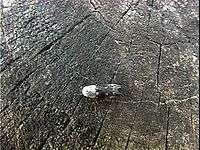Trachypepla euryleucota
Trachypepla euryleucota is a species of moth in the family Oecophoridae. It is endemic to New Zealand.[2]
| Trachypepla euryleucota | |
|---|---|
 | |
 | |
| Scientific classification | |
| Kingdom: | |
| Phylum: | |
| Class: | |
| Order: | |
| Family: | |
| Genus: | Trachypepla |
| Species: | T. euryleucota |
| Binomial name | |
| Trachypepla euryleucota | |
Taxonomy
.jpg)
This species was first described by Edward Meyrick in 1883 using specimens collected in Auckland, Wellington and Dunedin.[3] Meyrick gave a more detailed description of the species in a paper published in May 1884.[4] George Hudson discussed and illustrated this species in his 1928 publication The Butterflies and Moths of New Zealand.[5] The type locality of this species is the Botanic Garden and forest in Wellington.[6] The lectotype specimen is held at the Natural History Museum, London.[6]
Description
Meyrick described the species as follows:
Male, female.— 14-17 mm. Head, palpi, and antennae dark fuscous. Thorax white, anterior margin dark fuscous. Abdomen fuscous. Legs dark fuscous, apex of tarsal joints obscurely pale. Forewings elongate, costa arched towards base and apex, rest nearly straight, apex round-pointed, hindmargin very obliquely rounded ; dark fuscous ; a large white basal patch, slightly ochreous-tinged, outer edge slightly irregular, extending from 1⁄4 of costa to before middle of inner margin ; a small elongate blackish spot on base of costa ; two large spots of raised ochreous-brown scales, partially black-margined, in disc before middle, and two smaller ones beyond middle ; a small somewhat triangular inwardly oblique white spot on costa at 4⁄5 , emitting from its apex a slender white outwards-angulated line to hindmargin above anal angle, anteriorly blackish-margined : cilia fiasco as-grey, with an obscure darker line. Hindwings fuscous-grey, darker towards apex ; cilia fuscous-grey, with an obscure darker line.[4]
Distribution
This species is found throughout New Zealand.[7]
Biology and behaviour
Adults are on the wing in December and January.[5] They have been taken when the manuka (Leptospermum) was in blossom. It is thought that when adults sit at rest its white head, thorax, and basal portion of wings are of protective value by reason of their resemblance to an opening manuka-bud.[7]
Larvae have been found feeding on bird nest debris.
References
- "Trachypepla euryleucota Meyrick, 1883". www.nzor.org.nz. Manaaki Whenua-Landcare Research. Retrieved 4 November 2018.
- Gordon, Dennis P., ed. (2010). New Zealand inventory of biodiversity. Volume two. Kingdom animalia : chaetognatha, ecdysozoa, ichnofossils. Vol. 2. Christchurch, N.Z.: Canterbury University Press. p. 462. ISBN 9781877257933. OCLC 973607714.
- Meyrick, Edward (1883). "Descriptions of New Zealand Micro-Lepidoptera. III. Oecophoridae". New Zealand journal of science. 1: 522–525 – via Biodiversity Heritage Library.
- Meyrick, Edward (May 1884). "Descriptions of New Zealand Micro-Lepidoptera". Transactions and Proceedings of the New Zealand Institute. 16: 1–49 – via Biodiversity Heritage Library.
- Hudson, G. V. (1928). The Butterflies and Moths of New Zealand. Wellington: Ferguson & Osborn Ltd. p. 283. OCLC 25449322.
- Dugdale, J. S. (1988). "Lepidoptera - annotated catalogue, and keys to family-group taxa" (PDF). Fauna of New Zealand. 14: 106. Retrieved 4 November 2018.
- "Trachypepla euryleucota". www.terrain.net.nz. Taranaki Educational Resource: Research, Analysis and Information Network. Retrieved 2018-11-04.
External links
| Wikimedia Commons has media related to Trachypepla euryleucota. |
| Wikispecies has information related to Trachypepla euryleucota |